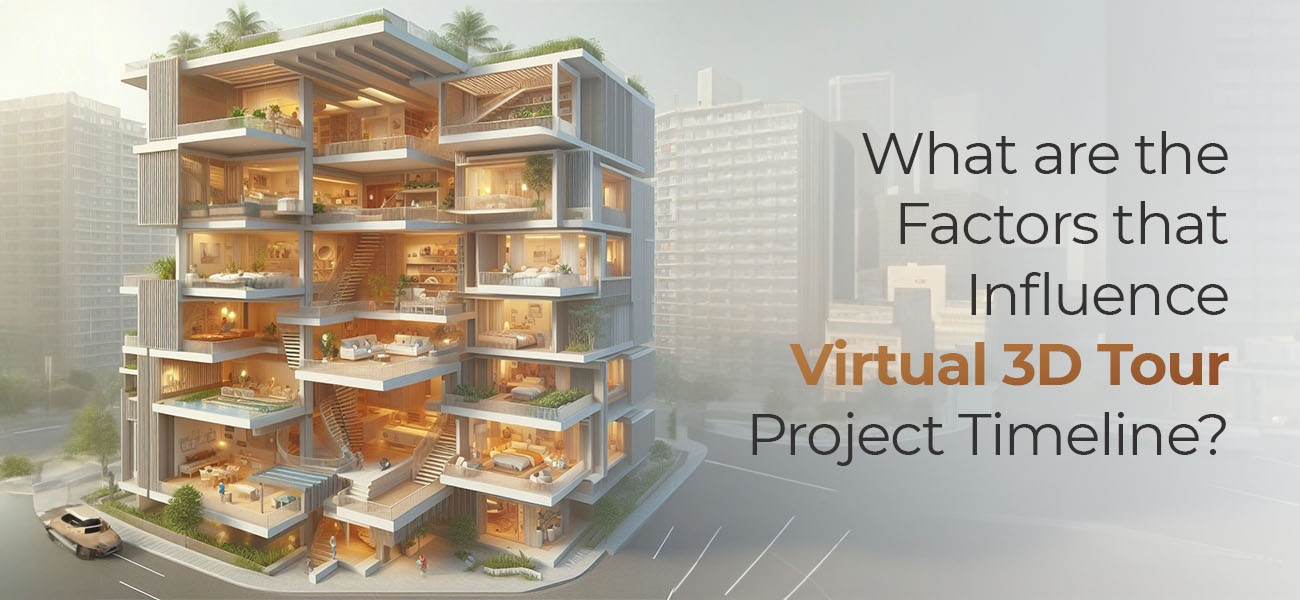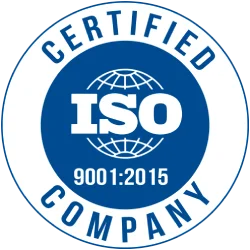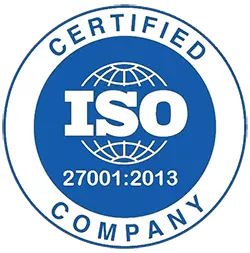What are the Factors that Influence Virtual 3D Tour Project Timeline?

Real estate virtual tours are interactive and immersive 360° replications of physical property tours. These digital journeys are quite impressive, as interested buyers can check a potential property without actually being present there. The CGI-generated 3D twin of the property is projected to potential buyers with the help of VR technology. In the digital era, 3D virtual home tours are the most practical way of showing a property to stakeholders.
Moreover, online listings are further boosted with a 3D tour rather than static visuals. That said, numerous big-shots in the real estate sector have adopted 3D virtual property tours as a convenient mode of property showcasing.
However, as convenient and practical as it sounds, the creation of these virtual walkthroughs is pretty complex. The project timeline for virtual tour creation is influenced by several external factors. This article will discuss all the factors that determine the timeframe of a real estate virtual tour project.
Stick with us until the end, and you will gain a valuable piece of knowledge that can help you in your 3D walkthrough creation workflow. Let’s begin!
How 360° virtual property tours have revolutionized the real estate sector?
The virtual reality market is expanding every day. Back in 2020, the market segment was valued at a whopping $15.81 billion. Researchers have predicted that by 2028, the virtual reality domain will have a CAGR of almost 18%.
Thus, it can be safely said that this is a great time to leverage the potential of 360° 3D visualizations. And as we speak, several sectors have already leaned onto it. Right from eCommerce, fashion, and healthcare to automobile manufacturing and travel/tourism, 3D rendering is present. Among all, the real estate sector stands out when it comes to adapting innovative 3D technologies.
It is one of the industries that has swiftly and successfully implemented 3D-rendered visuals as well as interactive architectural walkthroughs. By incorporating this technology, realtors offer a fantastic immersive experience to the target audience. Interested buyers can walk through a digitally simulated version of a physical space and get a better understanding of it.
This whole concept has brought about a major tactical change in showcasing properties. Prospects can now experience remote tours of open houses from the comfort of their homes. Buyers can take numerous tours on the same day without even moving from their place or physically visiting every property.
Statistics show online property listings with a virtual walkthrough option get almost 87% more views than plain listings. Nearly 67% of respondents to a Google survey expressed interest in 3D designs and renderings. The study also showed the participants demand for virtual home tours.
Another study showed that almost 75% of property investors consider virtual tours a significant deciding factor. Adults whose demography varies between 18 to 34 years old are 130% more likely to invest in a property after experiencing a virtual tour. As VR-powered architectural tours gain more momentum, knowing what factors influence their duration is imperative.
The following section will detail all those in clear detail.
The factors affecting and influencing real estate virtual tour creation timeline
-
Number of viewpoints
How many interactive viewpoints will be there in the tour affects the timeline. In simple words, viewpoints showcase the best camera angles. This ultimately projects the room or the space in its best view. Thus, viewpoints are of crucial significance when it comes to 3D property walkthroughs.
These panoramic, 360° projections ought to be highly detailed and in many numbers so as to make the tour seamless. The larger the space, the more viewpoints are required to create. Viewpoints actually make a 3D tour interactive.
That said, a high-quality virtual tour can have more than 200 viewpoints. Given their significant role in making a virtual real estate walkthrough a success, these must be created with adequate dedication and precision. Understanding where exactly the camera is to be placed is imperative. Thus, the higher the number of viewpoints, the longer the timeline.
-
Resolution of the final renders
The resolution quality of the final renders is one of the most important determining factors that affects the timeline for virtual property tours. A large set of panoramic images make up a virtual tour. These must look hyper-realistic to replicate the real-world property, with well-textured details. The higher the resolution, the longer the rendering time.
The standard resolution for these is 6K, but if you want superior quality, you can go as high as 15K. Only a professional agency with advanced tools can deliver such top-notch quality. Image resolution is also synonymous with the level of detail. The more intricate the details are, the better the presentation. But simultaneously, the timeline escalates owing to the efforts required. Useful Article : Image Resolution for 3D Rendering and Animation: A Quality Guide
-
Custom 3D model creation from scratch
If the client provides the 3D model and only the rendering part is to be done, the efforts tend to lessen. This makes the timeline short since one of the technical pre-production processes is already done. However, if 3D models and scenes are to be custom-created from scratch, the effort multiplies, as does the timeline.
Let us explain this in more detail. Creating custom 3D models is a highly time-consuming task for 3D artists. A lot of technical aspects are involved in it. Besides, the effort is almost triple for virtual tours, where a plethora of elements are featured. This somewhat gets simplified when CGI artists use ready-made 3D models from a 3D asset library within their workflow. But if the client prefers custom-designed models, the timeline gets stretched. Mostly owing to the greater amount of effort to be put in.
-
Perfection level in light and mood
Achieving the perfect lighting, theme, and mood is another challenging aspect of virtual walkthrough creation. The project timeframe depends on this factor to a great extent. As we know, lighting and shadow play a significant role in all panoramic renders, especially for real estate. As well as the theme and aesthetics.
These two components create the mood of the entire walkthrough, which in turn influences the customer’s purchase decision. However, striking a perfect consistency between light, shadow, and aesthetics is tough and requires a great deal of work. Also, more of these elements are present in the 3D tour, and more post-production fine-tunings are to be made.
-
Complexity of interiors and exterior architecture
Another vital denominator that affects the virtual walkthrough development process is the complexity of the architecture. Be it the exterior or the interior, the complexity of a room or floor plan extends the time taken to render the scene.
If irregular space, art deco patterns, and geometrical components are present in the room or the exterior portion, this implies a lot of complexities to tackle by the rendering professional. Also, if there are varying height levels between each of the spaces featured within the tour, that stretches the development timeframe.
-
Number of iterations required
This is pretty self-explanatory. The more iterations or changes requested, the longer the turnaround time. Usually, the number of revisions is mentioned during the project proposal or quotation development. Naturally, if this number exceeds the defined scope, the project completion time will stretch longer.
That’s why it is utmost necessary to get things right in the initial rounds of changes. As well, from the client’s end, it is vital to define everything within the scope. This saves a lot of rework and unnecessary back and forth, eventually reducing the timeline.
-
Involvement of a rendering farm
Professional 3D rendering agencies usually have a lot of architectural rendering and tour creation projects. Therefore, often, they resort to using high-performance computer systems or computer clusters, also known as render farms. Such render farms offer super high-end rendering capacity and generate state-of-the-art image quality. At the same time, the time taken for the whole process is much less.
Thus, if you are collaborating with a 3D rendering service provider for any walkthrough animation project, see if they deploy a render farm. If yes, then automatically, you’ll get your project much faster. There you go! Seven proven factors influence 3D photorealistic virtual tour production. Each factor is distinct from the others and equally important in the rendering process. A mix of all these scenarios, or even any one of them, can increase or reduce the project time. So whether you are a realtor or a renderer, be mindful of these factors while investing in or quoting the project, respectively.
Now, let’s quickly glance through a few of the best practices of virtual walkthrough development that will solidify your success in the domain.
What makes a great virtual property tour? - The best practices
Whether you are a real estate dealer, a developer, an architect, or a 3D rendering service provider, your ultimate aim is to satisfy your clients with a compelling view of the property. That said, in order to develop such a visually enthralling simulation in 3D, it is always a great idea to follow certain best practices.
Take a look at some of these strategies for the best virtual tour production. And if you want, keep this article bookmarked.
-
Ensure the property is ideally staged
This is very important in virtual tour planning. Ensure the property you want to showcase has every inch of it simulated real-world rooms and living spaces. If it is an office space, arrange relevant ergonomic furniture and furnishings. The best part about all this is that you do not have to do it physically. This implies that the entire property can be digitally staged.
With virtual staging, you can transform a vacant property into a delightfully decorated home replicating real-world elements. This helps the would-be buyers picture themselves within the property.
-
A seamless navigation is imperative
The rendering artist must ensure the navigation is smooth and seamless for the viewers. Bumpy visual jerks can deviate from them and make them lose their interest. The movement from one place to another must be as smooth as possible. Prospects must easily move around rooms, check every corner, and go from one place to the other smoothly.
Such well-timed functionalities give them a sense of control, creating a positive user experience.
-
Check the lighting; make sure it is consistent throughout
Lighting plays a pivotal role in the overall success of a virtual 3D tour. Dimly lit rooms and near-dark spaces are unwelcoming. As well as making the areas appear smaller than they really are. Bright lighting changes the dimensions and uplifts the general impression of the property.
Whereas inconsistency in lighting creates a jarring effect that is less inviting,. So, make it certain that every corner of the property is well-lit and has consistency in lighting. During the project management of virtual tour production, maintaining this falls under one of the best practices.
-
Give more focus to the unique features of the house
It goes without saying that each property has its own USPs (unique selling proposition). In simple terms, this implies the critical highlights of the plot. The digital walkthrough must give prime focus to these key points.
It can be the wall colors, a nice modular kitchen, a well-decorated study or library, or even an antique decor piece. Anything that makes your property stand out.
Useful Article: Top Things to Consider About 3d Home Design
-
The 3D viewpoints must reflect human perspectives accurately
Until and unless you are 100% sure each viewpoint accurately reflects the human perspective, never give the 3D tour a green signal. Because if the 3D viewpoints do not replicate what the human eyes see, it defeats the entire purpose of creating a virtual walkthrough tour.
Place the viewpoints in natural stopping points instead of focusing in the centers. This will accurately mimic the in-person viewing experience of the prospects, which is exactly why these virtual tours are made for.
-
Don’t forget the outdoors
While you showcase the key features of the indoors as much as you want, remember that the outdoor area also plays a major role in creating a positive perception of a plot. Prospective buyers are usually keen to check out the outdoors and the surrounding neighborhood before making a purchase decision.
So, if possible, feature the neighborhood areas within the tour. Also, if the property has a lawn or a garden, stage or decorate the area with relevant furniture or decor items. Of course, this can be done virtually.
-
Include 3D floor plans within the tour
3D floor plans are incredibly significant for interested property buyers. Floor plans give a clear idea of the size and dimensions of the space. As 3D floor plans give a view from above, buyers can get proper clarity regarding each room size compared to the others.
This further helps them decide the kind of furniture required for each area and what their ideal size should be.
Useful Article: How 3D floor plans help to increase property sales
-
Collaborate with a professional virtual 3D tour creation company
Lastly, ensure you work with an expert team of 3D professionals for your dream real estate project. External 3D service providers are masters of their art and have highly experienced 3D artists on their teams.
They also have unlimited access to all the latest technologies and software required to create the best 3D tours. Most of all, their service charges are nominal and negotiable. In terms of the project timeline also, one can rest assured of the super-fast delivery and high-quality outcomes.
Conclusion
Hope you have enjoyed reading this extensive and detailed account of:
- Virtual 3D tours
- The factors affecting virtual tour development timeline, and,
- The best practices of virtual tour optimization
As we now understand, virtual tours enhance the digital marketing strategy of any real estate agency. Be it for property listing or advertising on a website, this VR technology-driven functionality is in high demand in the 21st century. The in-person experience would-be buyers get from this experience can never be replicated in any traditional methods.
Being mindful of the factors mentioned above will help any realtor or renderer to be prepared beforehand. This basic understanding of the timeframe determiners is crucial for any 3D virtual tour project creation to be a success.
So, if you own a real estate agency and want to enhance your brand’s marketing endeavors, consult an expert 3D service providing company. Good luck!
Reach us

